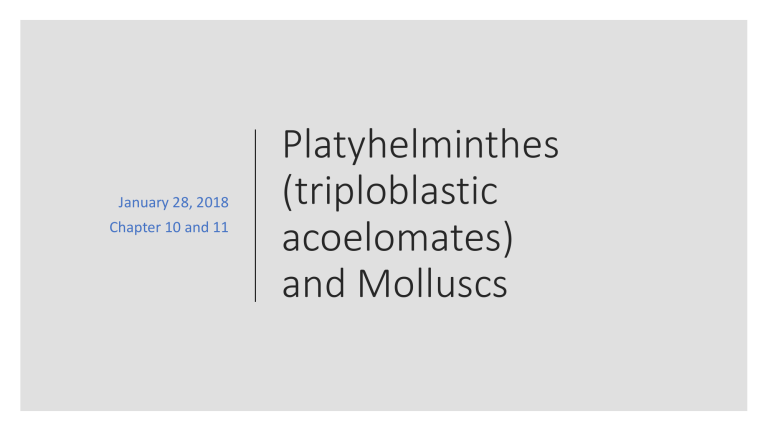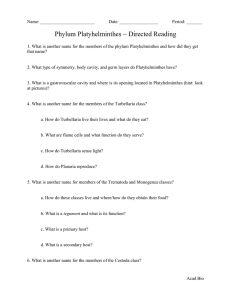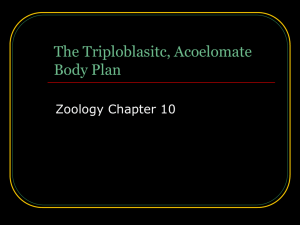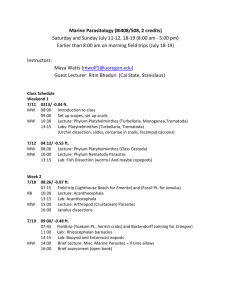WILD 114 INTRO TO ZOOL LECTURE 6 PLAYTHELMINTHES AND MOLLUSCA CHAPTER 10 AND 11
advertisement

January 28, 2018 Chapter 10 and 11 Platyhelminthes (triploblastic acoelomates) and Molluscs Body plans review Porifera to Annellida…. Figure 10.1 Lophotrochozoan Relationships. Evolutionary Perspective • Platyhelminthes are protostomes and lophotrochozoans • Protostomes display spiral cleavage, mouth develops from blastopore • Lophotrochozoans share: • a lophophore, horseshoe shaped structure used in feeding • OR a trochophore larval form Platyhelminthes: General Characteristics • • • • • • Flattened dorsoventrally Triploblastic, acoelomate Bilaterally symmetrical unsegmented worms Incomplete gut Cephalized - they have a “head” Usually monoecious - “one house”; complex reproductive organs • Mesodermally derived tissue includes a loose tissue called parenchyma • First animals we encounter that have an organ system of organization rather than just tissues Phylum Platyhelminthes • The phylum is divided into four classes • The Turbellaria consist of mostly free-living flatworms • The Monogenea are parasitic • The Trematoda are parasitic • The Cestoidea are parasitic Class Turbellaria • Free-living flatworms in fresh and salt water • 3,000 species • Includes the well-known Planaria (genus Dugesia) • Most active carnivores – a few eat vegetation • Amazing powers of regeneration – you can cut one in half and it will become two flatworms! Figure 10.3 Phylum Platyhelminthes: Class Turbellaria. • Ocelli present (simple eyespot) and usually negatively phototactic • Movement using both cilia and muscular contractions • They are able to detect food by chemical means (chemosensory) • Several kinds of digestive tracts – see fig. 10.5 – they usually begin the digestion process outside the body • Respiration is achieved by diffusion - no gills or lungs or anything like that • Waste removal also accomplished by diffusion Class Monogenea (flukes) • • • • • One egg = one adult Mostly ectoparasites on the gills of fishes A few found on frog bladders One lives in the eye of a hippo….. They are usually very species specific and site specific in their attachment and do not have multiple host species • Opisthaptor is used for attachment • Flukes—mostly parasites of vertebrates • Medically important human parasites • Chinese liver fluke • Sheep liver fluke • Schistosome flukes (blood flukes) • Usually very small, up to 6 cm • An incomplete digestive tract is present • Most are monoecious Class Trematoda • The outer body layer is a tegument (continuous layer of fused cells) Figure 10.12 Class Trematoda: Subclass Digenea. Figure 10.13 Chinese Liver Fluke Clonorchis sinesis. Trematode parasites and amphibian deformities • Cestodes, or tapeworms, are gut parasites of vertebrates Class Cestoidea • Two unique adaptations characterize the group: • Lack a mouth and digestive tractabsorb nutrients across body wall • Most consist of a series of repeating units called proglottids • each has one or two complete sets of reproductive structures Figure 10.17 Life Cycle of the Beef Tapeworm, T. saginatus. Phylum Nemertea – Proboscis Worms • About 900 species of proboscis worms that are mostly marine • Mostly live in mud and sand • Complete digestive tract • More advanced “circulatory” system than platyhelminths • Dioecious • Some can be more than 30 m long!! Figure 10.25 Phylum Nemertea. Phylum Cycliphora • Newest phylum to be named! • Live on mouthparts of claw lobsers • One of the most recently described phyla • Members of this phylum live on the mouthparts of the claw lobster • Attach via an adhesive disc on the end of an acellular stalk • Very tiny animals Phylum Cycliophora Figure 10.26 Phylum Cycliophora. • Characteristics: • Body is made of 2 parts • Calcareous shell • Bilateral symmetry • Trochophore larvae • Open circulatory system radula present and used to scrape food Chapter 11 - Molluscs Movement is accomplished with a large foot The radula moves similar to the treads on an army tank and serves to pick up food • Snails, limpets and slugs • 35,000 species • Largest and most varied group of molluscs Class Gastropoda- the stomach foot • Gas exchange involves the mantle cavity (notice the little gill) • Open circulatory system • Hydraulic skeleton • Have photo and chemoreceptors • Can be dioecious or monoecious Gastropods Class Bivalvia • Clams, oysters, mussels, and scallops • Many are edible • Some cam make pearls! • Small, translucent, freeswimming • Swim using ring of cilia • Veliger has large, ciliated lobes: velum • Swimming, feeding, gas exchange Bivalve life cycle • Bivalves pull food inside the shell for digestion • Open circulatory system • Nerves = 3 connected ganglia, some have photoreceptors complete with retina! • Most bivalves have 2 sexes with external fertilization the norm Bivalve Internal Structure • Most complex of the molluscs • Most modern cephalopods do not have a shell • Shell is internal in cuttlefish Class Cephalopoda Introduced Bivalvia Two families have been introduced from Europe – the Asian clams and the zebra and quagga mussels http://www.fws.gov/midwest/mussel/images/zebra_mussels_on_native2_620.jpg Reproduction in Bivalvia • • • • • • Mostly dioecious Mostly external fertilization Many brood the developing young Trochophore and veliger larval stages Glochidium is a larval stage in some species The mussel in our area uses a “lure” to attract a fish, then the glochidium attach to the fish where they continue to develop and then fall off as “minature clams” Movement • Predators that hunt by sight • Have jaws with radula • Muscular digestive tract • Closed circulatory system • The most sophisticated nervous system of all invertebrates! • Excellent vision- similar to that of a cat • Two sexes- internal fertilization Feeding, Digestion, Reproduction • Eggs area attached to substrate • Brain to body ratio the largest of all invertebrates, fish, and amphibians • They can learn via observation • They can be trained- to a degree Intelligence The amazing cuttlefish! • Live in shallow marine habitats • Important food to many Native people • Crawl along like a snail and can grip tightly to rocks • Eat algae • Two sexes and external fertilization Class PolyplacophoraChitons • 300 species of burrowing marine animals • Head and foot extend from one end of the shell • Gas exchange across the mantle helped by water flow through the shell • Separate sexes • External fertilization Class Scaphopoda – tooth and tusk shells • One undivided arched shell • They have a foot, a radula, and gills • Two sexes • Most of the life history is still unknown • 25 species have been described Class Monoplacophora • These animals are threatened by invasive species and diminished water quality • Do not form strong attachments to substrate and can be removed easily • Important food resource traditionally Montana Native Mussels



